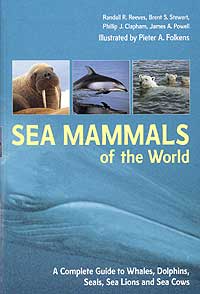
Sea Mammals of the World - a Complete Guide to Whales, Dolphins, Seals, Sea Lions and Sea Cows

Randall R. Reeves, Brent S. Stewart, Phillip J. Clapham, James A. Powell. Illustrated by Pieter A. Folkens
A&C Black Publishers Ltd, 2002 ISBN 0-7136-6334-0
Beautifully designed thick boek (527 pages), abundantly illustrated with photographs, drawings, general and distribution maps. It mainly deals with whales and dolphins in a very clear way, but there also is room for seals and the other sea mammals of the world.
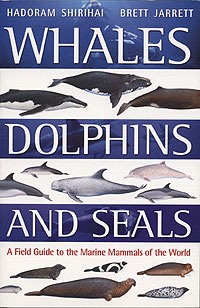
Whales, Dolphins and Seals - A Field Guide to the Marine Mammals of the World

Hadoram Shirihai and Brett Jarrett
A&C Black Publishers Ltd, 2006 ISBN 0713670371
I have not yet found time to study this guide, which is nice to handle due to its format. But the amazing photographs alone justify its purchase. At a first glimpse, the textual information seems to be just as thorough. 384 pages, 75 colour plates, 22 comparison plates, 470 photos, 100 maps.
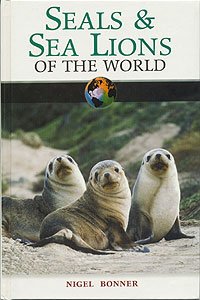
Seals & Sea Lions of the World

Nigel Bonner
Hardcover, 2004. 224 pages, 115 photos, 22 line illustrations, 25 distribution maps.
Nigel Bonner dedicates one chapter for each of the groups of pinnipeds: fur seals, sea lions, walrus, northern seals, monk seals, sea elephants and southern seals. Formerly a researcher working for the British Antarctic Survey, the author describes the distribution, breeding and feeding behaviour for each one of the species, with a focus on the Antarctic fur seals and true seals yet without forgetting the northern hemisphere. This book certainly is not an identification guide, but it is a very good source to enrich one's knowledge on these sea mammals. He writes in an easy language, providing many interesting details as well as his own view. Each chapter deals with animals that are closely related, thus avoiding repetions; it also helps to understand similarities and differences between the species. The last couple of chapters deal with sealing ( ing), interaction with fisheries and pollution. The book contains many illustrations and photographs, some not of great quality but always relevant and clear. If there would be a minor point it would be its layout which looks a bit outdated; yet it was published as recently as 2004.
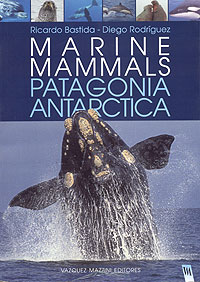
Marine Mammals Of Patagonia And Antarctica

Ricardo Bastida & Diego Rodríguez (translation by Dolores Elkin, editing by Crawford Mackeand)
Publisher: Vazques Mazzini Editores (2005) ISBN 987-9132-11-4
The original Spanish version of this book (Mamíferos Marinos - Patagonia y Antártida) appeared in 2003, and this English version finally makes the knowledge about sea mammals in and around Patagonia and Antarctica finally available for a broader audience.
This book covers all whales (12), dolphins (25), fur and true seals and other marine mammels that have even been recorded in this region - many more than will ever be seen by anyone, and including those species that only live in the northern part of Patagonia. This book has been setup as a guide, but other available guides are much better at achieving this goal: many photographs are of poor quality (including ones of very common species that are easy to approach). The interest in this book really lies in the fact that it presents the topic from the South-American point of view: how many dolphins are still being commercially exploited by Peru, mass strandings in Buenos Aires, research, population estimates, etc. The origin of specie's names is interesting reading too, but is repeated each time for similar species.
The Engelish text is fine, but the translator left a few errors (Papua Penguin instead of Gentoo Penguin) and spelling and interpunction errors are not uncommon, as well as factual errors (such as the fur seal being 'the only species of sea lions', while it is clearly not a sea lion at all, but a fur seal, p. 42!). It is a pity too that the text has not (really) been updated in the English version, there is no mention of the Leopard Seal attack on a British researcher. Instead the text states that this seal is 'passive in presence of man'. I would have liked to see colour illustrations of each species instead of the black and white ones, and I also miss an indication of month/year and location in each of the illustration's captions. But still this is a good reference book for anyone interested in the Argentine knowledge on sea mammals in this region.
208 pages, with illustrations and photographs in colour and black and white.
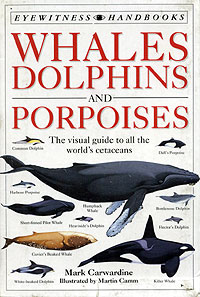
Whales, Dolphins and Porpoises

The visual guide to all the world's cetaceans
Mark Carwardine
Publisher: Dorling Kindersley Ltd, UK 1995. ISBN 0.7513.1030.1. Illustrations by Martin Camm
256 pages. Using many illustrations and photographs, maps, this guide provides an overview of what there is to know about whales, porpoises and dolphins. At-sea identification will always be difficult, but the illustrations of characteristic diving patterns and blow shapes of whales may help the reader a bit.
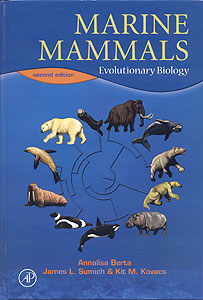
Marine Mammals - Evolutionary Biology **
Annalisa Berta, James Sumich & Kit Kovacs
Academic Press 2006. 2nd print. ISBN 0-12-088552-2
576 pages. Detailed. The hardcover makes it easy to hold. Once one has read the basic books on sea mammals, this book provides the next level of detail. This implies that it will be too much laysman, but on the other side: where can you find a summary, so clearly and structured presented, of all scientifical research on sea mammals? Each chapter concludes with a long list of related publications. The book contains many clear black and white drawings. The photographs are in monochrome, which is not a problem but their poor quality sometimes is. Includes extensive glossary and a small photo appendix, in colour.
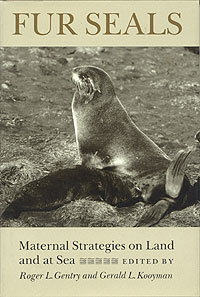
Fur Seals - Maternal Strategies on Land and at Sea

Rodger L. Gentry, Gerald L. Kooyman
Princeton University Press, 1986. ISBN-10: 0-691-08399-1
291 pages. Hardcover.
'Fur Seals' analyses which strategy is applied by two groups of female fur seals to raise their pups. The first group, the 'polar seals' (Northern and Antarctic) raise their young during a short summer season when food is abundant. The second group are the fur seals of warmer regions (South Africa, South America and the Galápagos), where the season is much longer but food availability is much more insecure. A good example of this scarcity is the 1983 season, which happens to be year in which El Niño strikes. The authors have studied five species of fur seal and one sea lion. The results are presented in a very structured manner; for each species a chapter is dedicated to the land-based behaviour (female attendance: suckling, resting, grooming) and another chapter to sea-based or 'diving behaviour'. This is exactly what the book's subtitle promises. The analyses for at-sea behaviour is based on results from the TDR (time depth recorder), a device which records when and how deep the animal was diving. TDR's enable researchers to understand swimming distances and speeds, diving depths and other data. So far, only Weddell Seals had been instrumented with a TDR, but it had never been applied to fur seals.
I expected this book to be too technical, but the systematic and clear presentation of the data (also graphically) of the 265 pages makes this book very readable. Each chapter concludes with an excellent summary, and the last chapter summarizes the entire book. The chapters on the diving behaviour of the Antarctic Fur Seal and the one on the effects of El Niño on the South American Fur Seal were very interesting too. This study includes an extensive literature list and subject index, a couple of black and white photographs and many graphics.
TDR's have probably been improved since this book was published (1986); possibly they are now able to record new parameters such as shallow dives. But although the data may not be the most recent (any more), the book gives a good insight in how fur seal mothers raise their pups in cold and warmer waters. There is another interesting comparison between the Galápagos Fur Seal and Galápagos Sea Lion: although they share the same feeding grounds, they are unlikely to compete because of differences in hunting and diving behaviour.